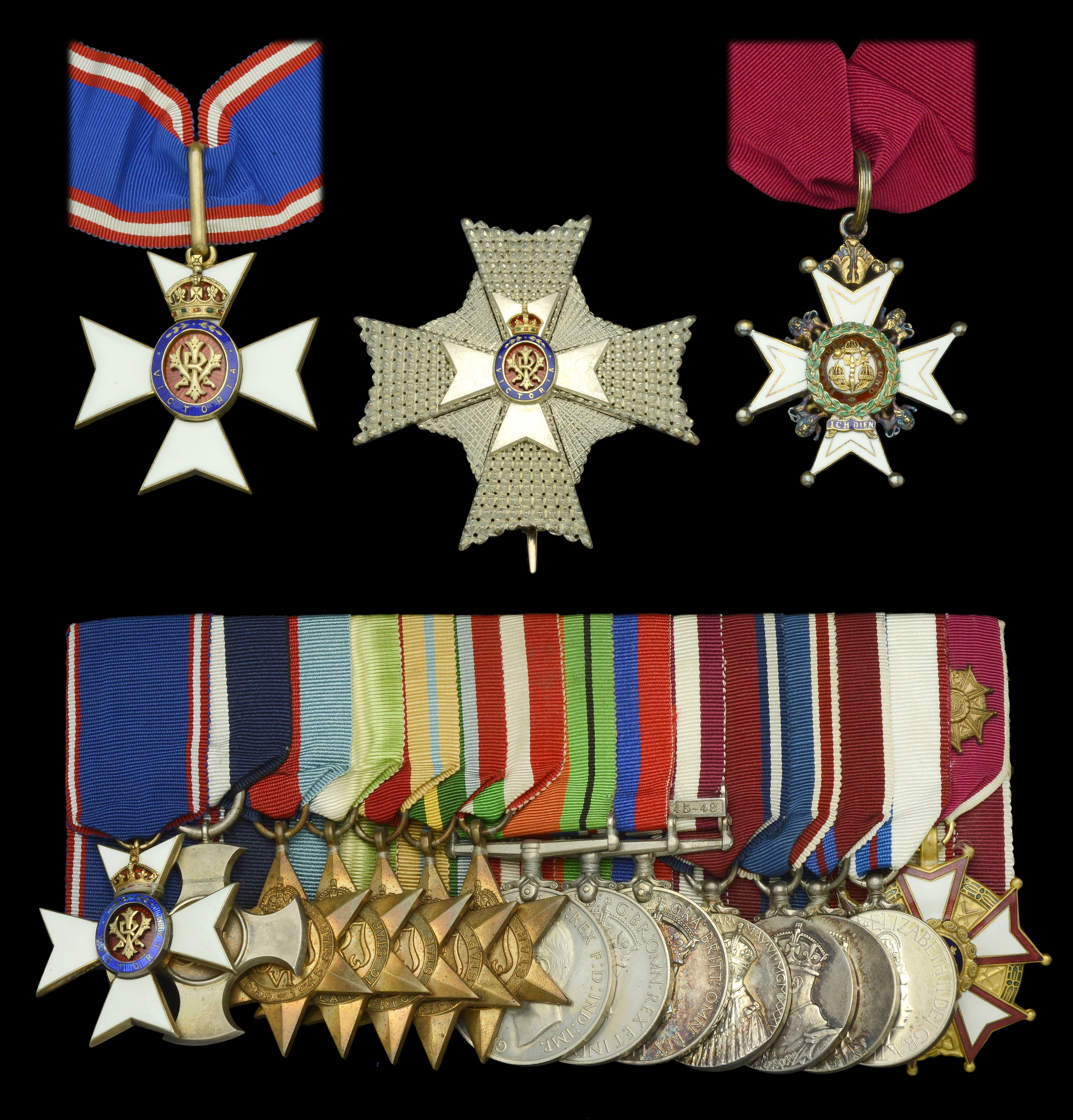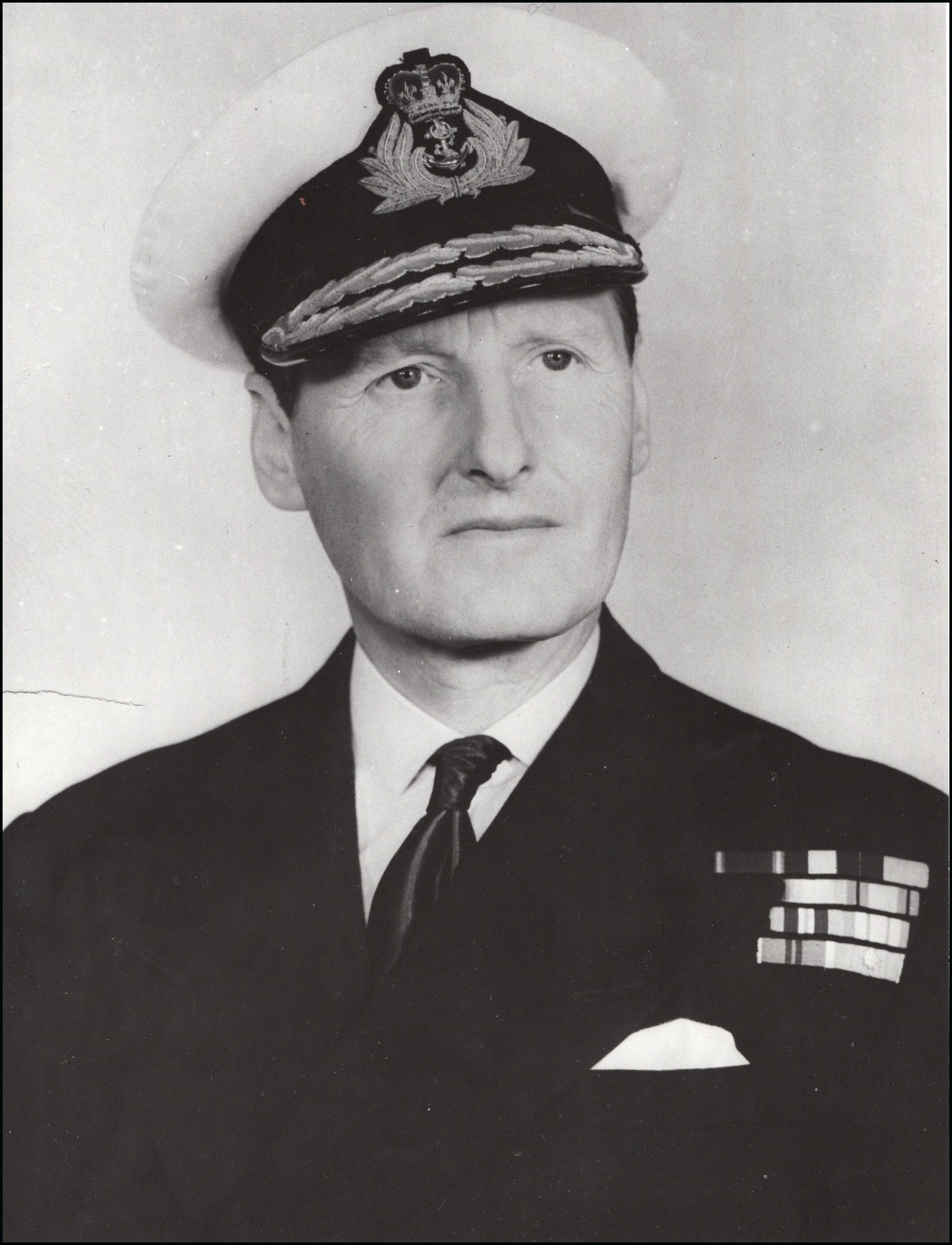An impressive post-war ‘Flag Officer Royal Yachts’ K.C.V.O., C.B. and Second War Scharnhorst action D.S.C. group of seventeen awarded to Vice-Admiral Sir Peter Dawnay, Royal Navy The Royal Victorian Order, K.C.V.O., Knight Commander’s set of insignia, comprising neck badge, silver-gilt and enamels, officially numbered ‘K303’ on reverse, and breast star, silver, with gilt and enamel centre, officially numbered ‘303’ on reverse, in Collingwood, London, case of issue; The Most Honourable Order of the Bath, C.B. (Military) Companion’s neck badge, silver-gilt and enamels, in Garrard, London case of issue; The Royal Victorian Order, M.V.O., Member’s 4th Class breast badge, silver-gilt and enamels, officially numbered ‘599’ on reverse; Distinguished Service Cross, G.VI.R, the reverse officially dated ‘1944’ and hallmarked London 1943; 1939-45 Star; Atlantic Star; Africa Star; Pacific Star; Italy Star; Defence and War Medals 1939-45; Naval General Service 1915-62, 1 clasp, Palestine 1945-48 (Cdr. P. Dawnay, M.V.O. D.S.C. R.N.); Jubilee 1935; Coronation 1937; Coronation 1953; Jubilee 1977; United States of America, Legion of Merit, Officer’s breast badge, gilt and enamels, mounted court-style as worn where applicable, M.V.O. chipped on central surround, otherwise generally good very fine or better (18) £5,000-£6,000 --- Importation Duty This lot is subject to importation duty of 5% on the hammer price unless exported outside the UK --- --- Provenance: Spink, July 2000. K.C.V.O. London Gazette 12 December 1961. An award for services as Flag Officer Royal Yachts during the Royal Tour of Ghana. C.B. London Gazette 1 January 1958. M.V.O. London Gazette 22 June 1939. An award for services as Flag Lieutenant to the Vice-Admiral Commanding the Royal Squadron during the Royal Tour of Canada and the U.S.A. D.S.C. London Gazette 7 March 1944: ‘‘For gallantry, distinguished service and devotion to duty on the staff of the Commander-in-Chief, Home Fleet, and in H.M. Ships… Duke of York… during the action in which the Scharnhorst was sunk.’ The original recommendation states: ‘Commander Peter Dawnay, M.V.O., R.N., served as Fleet Wireless Officer. The very high standard of W.T. efficiency which he maintained throughout the action, and upon which communications entirely depended, reflects the greatest credit upon his untiring efforts during the whole operation.’ American Legion of Merit London Gazette 28 May 1946; ‘For distinguished service in the Far East and in the United States of America.’ Peter Dawnay was born In London on 14 August 1904, the son of Major the Hon. Hugh Dawnay and his wife, Lady Susan. His father was killed in action commanding the 2nd Life Guards at Ypres in November 1914. Young Peter entered the Royal Navy as a Cadet in May 1918, attended the Royal Naval Colleges at Osborne and Dartmouth and was appointed a Midshipman in September 1922. He subsequently specialised in signals and, following seagoing experience in the battle cruiser H.M.S. Renown and in the battleship Queen Elizabeth - and promotion to Lieutenant in June 1927 - he was appointed Officer-in-Charge, R.N. Wireless Station, Aden. The following year he was selected as Flag Lieutenant to the C.-in-C. Africa Station and Fleet Wireless Officer in the Cardiff, and in 1933 he became a Flag Lieutenant to Rear-Admiral J. K. Thurn, under whom he had served in the Queen Elizabeth. Advanced to Lieutenant-Commander in June 1935, Dawnay was next temporarily appointed to the Victoria and Albert as a member of the Royal Entourage for the King and Queen’s visit to Canada. For his services during their subsequent Royal Tour, he was appointed M.V.O. On the outbreak of hostilities. he was serving at the Portsmouth Signals School, and in January 1941, on his promotion to Commander, he joined the Signals Division of the Admiralty. Then, on returning from the United States as Communications Officer of the British Admiralty Delegation in 1942, he was appointed Fleet Wireless Officer in the Duke of York, carrying the Flag of the C.-in-C. Home Fleet Admiral Sir Bruce Fraser. Sink the Scharnhorst! In December 1943, Dawnay was thus placed to play a vital role in the sinking of the Scharnhorst during the battle cruiser’s attempt to intercept North Russian Convoy JW-55. The whole affair, in the words of Dawnay’s colleague, Lieutenant-Commander ‘Dickie’ Courage, the Fleet Signals Officer, ‘was a communicator’s party, for all the events surrounding the passage of the JW-55 Convoy, including the actions against Scharnhorst, turned on communications.’ At 2 a.m. on the 26th, Admiral Fraser received intelligence that Scharnhorst had sailed from Alten fjord seven hours earlier to attack JW-55, and, accepting the risk that Scharnhorst would turn away if the Duke of York broke wireless silence, ordered the convoy to steer northwards away from the enemy. Next morning the cruiser Norfolk, a unit of the close covering Force 1, under Vice- Admiral Burnett, located Scharnhorst on radar at 33,000 yards, and with her consorts Belfast and Sheffield opened fire at the maximum limit of her range, causing Scharnhorst to break away at 30 knots. At 8.44 a.m. the communications staff in Duke of York intercepted Burnett’s first ‘Jig’ radar report on one of three broadcast frequencies which they monitored round the clock. This and subsequent enemy reports, Burnett addressed to Scapa W.T. at full power. But, as related by John Winton, in The Death of the Scharnhorst, Scapa was not heard to answer and Dawnay soon realised that the reports were not being received. He therefore ordered the reports to be retransmitted to Whitehall by ‘ship-shore’ frequency but, before doing so, consulted the C.-in-C., but by Dawnay’s own account, ‘found that he was so engrossed in the tactical situation that this was the only time I did so, and thereafter I took all decisions of this nature myself.’ Winton continues: ‘Because of Dawnay’s initiative, Duke of York’s signals were soon being broadcast worldwide by the Admiralty, sometimes within two minutes of being originated. Dawnay and Courage both had mental visions of Staff Officers and interested parties all over the world getting their maps and following the progress of the battle, as it actually took place. Bey and Hintze [of the Scharnhorst] might at one time have begun to feel themselves alone and beleaguered. Beleaguered they may have been, but they were certainly not alone; in fact they never had a bigger audience in all their lives.’ Then, however, as Dawnay recalled, ‘as the minutes went by and the contact was not regained it was realised that the situation had taken a bad turn for the worse.’ A period of acute apprehension ensued, Admiral Fraser fearing the Scharnhorst would escape his grasp. Winton continues: ‘It was one more problem for Commander Dawnay, the Fleet Wireless Officer, who had been having a somewhat harassing day, a great deal due to the inconvenient position of his Radio Control Office. ‘For to get to the Plot from the R.C.O., to talk to the Admiral, I had to go out on the bitter and dark wings of the bridge, where I was of course blinded, and then in through the Admiral’s bridge to the Plot, going through five doors in all. A wicked experience when in a hurry and doing it frequently. Afterwards I had the trap hatch between the R.C.O. and Plot enlarged so that I could just climb through it, rather than risk a repetition of that obstacle race … &r...









